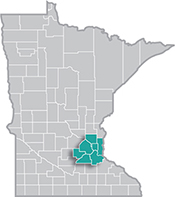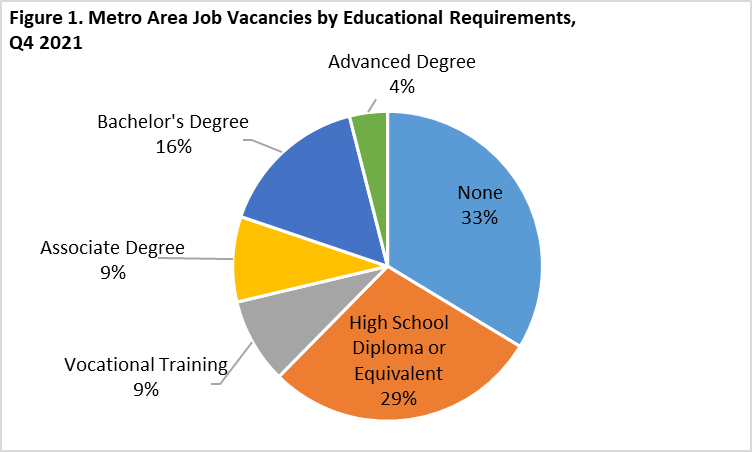 The Minneapolis-St. Paul metropolitan area is a national leader in finance, advanced manufacturing, agriculture and retailing.
The Minneapolis-St. Paul metropolitan area is a national leader in finance, advanced manufacturing, agriculture and retailing.
Medical devices, electronics and processed foods are strong suits recognized globally.
Want the freshest data delivered by email? Subscribe to our regional newsletters.
7/28/2022 9:00:00 AM
Tim O'Neill
Last month, the Metro Area Local Look blog highlighted the tight labor market conditions in the Seven County Twin Cities Metro Area. Specifically, we looked at the record number of job vacancies reported in the region, which topped out at nearly 127,000 during the fourth quarter of 2021. This month, we'll look at some of the characteristics of those 127,000 vacancies. This data comes from DEED's Job Vacancy Survey (JVS).

By educational attainment requirements, 38% of the Metro Area's 127,000 job vacancies required some level of postsecondary education or training beyond a high school diploma. This included 20% that required a bachelor's degree or advanced degree. In other words, nearly two-thirds of the Metro Area's job vacancies required no education beyond a high school diploma or equivalent. And this share of vacancies requiring a high school diploma or equivalent or no formal education has increased for both the region and state in recent years. This is likely due to the tight labor market, as employers look to expand their candidate pool by reducing educational requirements.
Of course, certain occupational groups and specific occupations require higher levels of postsecondary education. During the fourth quarter of 2021, those major occupational groups with the highest share of job vacancies requiring some level of postsecondary education included Life, Physical, & Social Science; Healthcare Practitioners & Technical; Legal; Architecture & Engineering; Management; Business & Financial Operations; and Educational Instruction & Library occupations. Each of these occupational groups had at least two-thirds of their respective job vacancies requiring some level of postsecondary education. Those occupational groups with the smallest shares of job vacancies requiring post-secondary education included Food Preparation & Serving Related, Transportation & Material Moving, and Building & Grounds Cleaning & Maintenance occupations.
Zooming in on another major work characteristic, just over one-quarter (27%) of the Metro Area's job vacancies were for part-time work. In this case, part-time is defined as fewer than 35 hours per week. Like the share of job vacancies requiring postsecondary education, the share of job vacancies in the region being for part-time work has declined in recent years. For example, about 40% of total job vacancies were for part-time work in 2016 and 2017. This decline of part-time work is likely due to employers aiming to better utilize their workforces.
Lastly, one can look up characteristics of job vacancies in the Metro Area by firm size as well. For example, of the Metro Area's nearly 127,000 job vacancies, about 17% were at firms with 1-9 employees, 39% were at firms with 10-49 employees, 22% were at firms with 50-249 employees, and the remaining 21% were at firms with 250 employees or more. Job vacancy rates, which estimate the percent of job vacancies relative to all filled jobs, were highest for smaller firms. This reveals that demand for workers is higher for smaller firms in the region currently. One can also analyze the share of job vacancies by firm size for part-time work and for requiring post-secondary education (Table 1).
| Table 1. Job Vacancy Characteristics by Firm Size in the Metro Area, Qtr. 4 2021 | ||||
|---|---|---|---|---|
| Firm Size | Number of Job Vacancies | Job Vacancy Rate | Percent Part-Time | Requiring Post-Secondary Education |
| Total, All Size Classes | 126,916 | 7.9% | 27% | 38% |
| 1-9 Employees | 22,089 | 15.0% | 18% | 48% |
| 10-49 Employees | 50,127 | 13.7% | 35% | 21% |
| 50-249 Employees | 28,337 | 6.2% | 25% | 39% |
| 250 Employees or More | 26,362 | 4.2% | 23% | 56% |
| Source: DEED Job Vacancy Survey | ||||
Check out DEED's Job Vacancy Survey online to learn more about job vacancies in Minnesota and its regions by industry, occupation, characteristics, and trends over time.